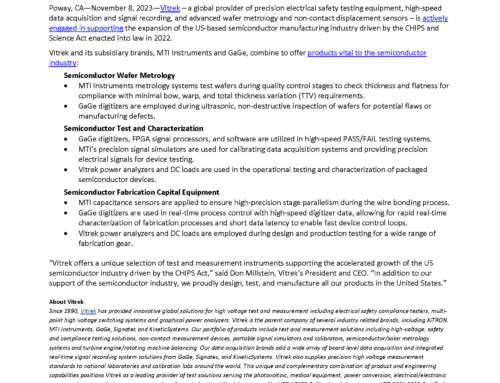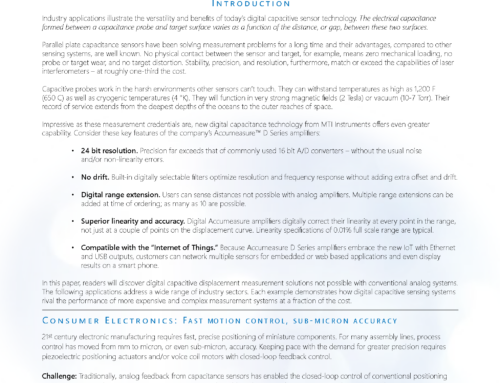Vitrek’s Automated Testing System Simplifies and Speeds Automotive Cable/Harness Testing
Testing system combines a hipot tester with Vitrek’s 964i switching system and QT Enterprise software; the automated
approach enables manufacturers to configure tests easily and access historical data

Introduction
With 20 or more harnesses, many interfacing with digital control devices, today’s vehicles have increasingly complex electronic systems. Precise and accurate continuity and cable testing must be performed on every connection during the assembly process to assure safety and reliability in the application.
This article presents a highly functional, automated approach to automotive/cable harness testing. It describes the features of the Vitrek products that make up the system — a hipot tester, multi-point switching system and automated software — and shows how these products work together to create a one-stop solution that simplifies and speeds the testing process and enables unlimited data storage for analysis and backup. It also describes how a test can be easily configured and offers a real-life test example using an EV charging cable application.
The Need for Automotive Cable/Harness Testing
Loose or mismatched electrical components cause the highest rate of failures in vehicles. Often the harness and components are inadvertently pinched, miswired or damaged during installation. Also, cable insulation that isn’t secured can wear through and cause eventual problems.
It is critical that automotive cable/harness assemblies are thoroughly tested and pass all necessary tests before installation in the vehicle. This assures optimum initial performance and that none of the subsequent failure modes can be attributed to a faulty cable.
Isolation (Insulation) Testing
The first type of vehicle harness testing verifies cable insulation for isolation, sufficiency and effectiveness. This simple insulation resistance test, also referred to as the DC hipot test, is performed using two conductors with an insulator between them. One conductor can be a vehicle’s chassis, for instance, and the other a 12V positive terminal coming off the car.
As illustrated in Figure 1, during isolation testing the user introduces high voltage to the limit desired. The user ramps up voltage from zero to 1000V, holds it for a specific time period, and then lets it discharge. During the test, a hipot tester is used to monitor the voltage to assure that excessive current does not flow from the conductor through the insulation to the other conductor.

Figure 1. Isolation Testing Using Hipot Testers
Ground Bond (Continuity) Testing
The second type of harness testing is ground bond, or continuity testing, which verifies proper connections. In this test, the user verifies resistance from chassis to earth by pushing either low or high current through a cable to see if there is a faulty connection. Depending on the source current (50mA to 40 A), the user can test for:
- Type test or production
- Resistance from chassis to earth
- Trip circuit breaker
- 4-Wire Kelvin measurement
- 100 milliohm typical limit
One example of ground bond testing is a 4-wire Kelvin measurement test that is used to measure low contact resistance. As shown in Figure 2, during testing, the user sources current across the DUT.
Conversely, for high resistance ground bond testing, the user pushes high current (power) through the cable. For example, at current levels up to 40 Amps, the conductor is stressed to create high resistance, which increases heat. If a faulty connection exists, runaway and failure will occur. Performed during installation, this test is key for avoiding future vehicle performance problems and, potentially, any unsafe conditions.

Figure 2. 4-wire measurement low-resistance testing
Vitrek’s Approach to Cable/Harness Testing
Vitrek offers a comprehensive approach to cable/harness testing that reduces testing time while delivering high-accuracy results as well as versatile reporting solutions. The combined system comprises three Vitrek products: a hipot tester, a multi-point switch and automated testing software. This section describes each product individually to illustrate how their advanced features complement and optimize the entire system.
1. V7X and 95X Series Hipot Testers
Vitrek’s combination cable/harness testing system utilizes either a V7X or 95X series hipot tester to perform insulation resistance, continuity and ground bond testing. Both units are rack mountable and can be used for stand-alone testing or, in this case, with Vitrek’s optional QT Enterprise software to perform automated testing.
With its high-resolution touchscreen, the V7X series hipot tester (Figure 3, lower right) is popular worldwide for being compact and easy to use. Features include AC and DC output voltages up to 5000 volts and 1uA resolution for leakage current.

Figure 3, Vitrek’s V7X (right) and 95X (Left) series hipot testers.
2. 964i High Voltage Switch
Also included in Vitrek’s combination cable/harness test system is the multi-point, multi-conductor 964i switching system (Figure 4). The 964i switch offers a range of configurable voltage ratings (3,7,10 and 15kV) with currents up to 70A. The unit has eight relays per card for a total of 64 test points, and it can combine multiple units to increase capacity.

Figure 4. Vitrek’s 964i high voltage switching systems, showing the front and back of the unit.
3. QT Enterprise Software
Finally, Vitrek’s combination harness/cable testing system utilizes QT Enterprise software, which enhances cable/harness testing by making it fully automated. Offering extremely helpful control capabilities, QT Enterprise enables the user to view a graphical representation of their test on a computer screen. They can also configure all test parameters, such as voltage and output, on easy-to-read display screens.
In the event of a failure during testing, the user can set the test to stop to either re-test with a new device or continue the test process and rework the existing device. When testing is complete, the user can save and document (and print) an unlimited number of tests on a central database. Depending on user permissions, tests can be accessed by model number, barcode or optional serial number, etc. Users can review historical data by day, batch, etc. and compare and analyze the testing results of various users.
Cable manufacturers find the software’s “global” settings especially helpful since they allow companies to personalize their testing processes. For example, a user can specify that all testing will start at a TIO or at the click of a mouse.
QT Enterprise Software
Figure 5 shows Vitrek’s combination cable/harness testing system. This example uses Vitrek’s model 95X series hipot tester, the 964i Switch and QT Enterprise software.
When paired with Vitrek’s hipot tester (or other manufacturer’s product), up to 16 chassis can be daisy-chained with hundreds of unique test points. This means the tester goes from having one high-voltage and one return point to having hundreds. The system offers a multi-conductor, multi-point automated test system with up to eight relays per card for a total of 64 test points.
Typically the user will run one high-voltage and a return lead to each point to run a test. The user can custom configure and display each switch according to the number and type of cards. Unlike typical cable testers on the market, the system allows each relay to be configured individually, which means easier testing of complicated devices.

Figure 5. Vitrek’s combination cable/harness test solution includes a 95X series hipot tester (top right), a 964i switch (bottom right) and QT Enterprise software (screen capture)
Utilizing QT Enterprise software results in automated testing by giving the user computer control of their tests. For instance, cable/harness tests can be configured according to specific performance parameters, including:
• Up to 15kV
• Up to 70A
• 64 relays per chassis
• 60 rear terminals
• Up to 16 chassis
• 100ms/point continuity test
• 1Sec/point voltage withstand test
• Each relay is individually controllable
• Can configure to connect anything to anything
The next screenshot (Figure 6) illustrates how a user can quickly set up and configure testing sequences. The purpose of this test is to make sure that everything is isolated or connected properly at very high voltages. When testing cables with this solution, the user can individually control each relay – and can connect anything to anything.
In this example, all 64 relays connected to the 964i switch are represented on the screen. As shown, the user has selected (checked) boxes “1” and “33” in the blue “Bank” columns. This means that the user wants to test isolation on whatever is connected from terminal 33 to terminal 1. Typically, relay 1 is on the return bank and relay 33 is on the high-voltage bank. (Although not shown here, the connection will appear as a block diagram.)
During this testing, the user can view exactly which steps make up the testing sequence. After the test is completed, the user can easily choose the next switch test to conduct from the sequence-summary menu.
 Figure 6. Vitrek’s QT Enterprise software provides a graphical representation of cable testing.
Figure 6. Vitrek’s QT Enterprise software provides a graphical representation of cable testing.
Application Example: EV Charger Testing
Figure 7, showing an EV charger, exemplifies a real-world application where Vitrek’s automated harness testing solution was used in an EV charging cable application.
The equipment/software used:
• Vitrek 964i high voltage switching system (and HVAC relays)
• Vitrek 952i hipot tester
• Vitrek QT Enterprise software
The testing parameters are:
• Validating EV charging cables
• Verifying ultra-low contact/cable resistance HV insulation
To conduct the test, the cable is placed inside a safety enclosure to ensure high voltage was not applied while the lid was open. Although Vitrek’s hipot testers have built-in technologies to limit discharge and quickly detect breakdown voltage, the enclosure provides additional operator safety and is recommended.
Because a tremendous amount of energy was put into the system, as fast as possible, the connectors needed to have very low contact resistance. Meanwhile isolation needed to be in the very high, 5000 V range. The EV connectors, each with multiple temperature-sensing pins, etc. required at least three to five conductors each, which added to the complexity of the test.
After specifying the relay sequencing using QT Enterprise software, the real-life application utilized the 952i hipot tester’s high-voltage isolation test capability and ability to measure resistance. The Vitrek 964i switch measured contact resistance in microohms, tested at 5000 volts isolation. This automated solution accomplished this testing in significantly less time compared to typical testing.

Figure 7. EV charging cable application
Conclusion
Vitrek offers manufacturers a turnkey solution for cable/harness testing in automotive applications. The automated approach speeds and eases test time by providing manufacturers with unprecedented control and data storage — plus access to unlimited historical data. Historical testing documentation also provides valuable backup for manufacturers in case of a subsequent failure.
As EVs emerge and automotive electronics increase in power and complexity, Vitrek continually optimizes its testing equipment to help technicians and engineers keep pace with industry safety and reliability requirements. In addition to providing an automated solution for high-voltage and isolation testing, as discussed here, Vitrek’s PA9xx series power analyzers offer a measurement/power conversion testing solution that tests to specific automotive standards. An informative whitepaper titled “Precision Power Analyzers: A Designer’s High Performance Tool Box” delves into the wide range of power analysis measurements performed, as well as examples of how these instruments facilitate testing for compliance to published standards.
All Vitrek products are made in the U.S. in an ISO-certified calibration lab. For more information or a free application review email info@vitrek.com or call (858) 689-2755.


